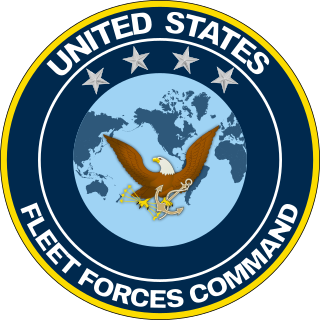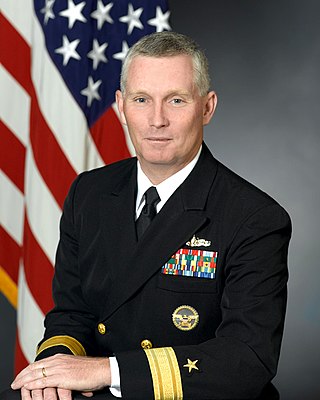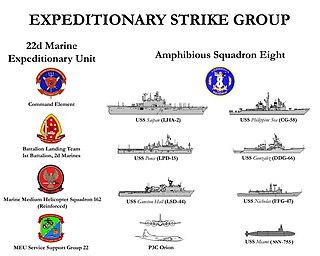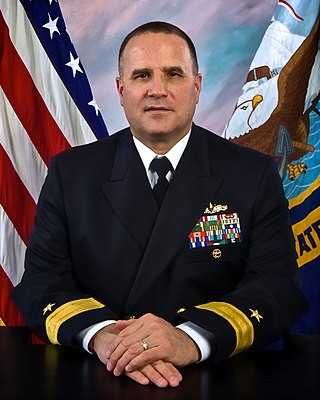
The United States Fleet Forces Command (USFF) is a service component command of the United States Navy that provides naval forces to a wide variety of U.S. forces. The naval resources may be allocated to Combatant Commanders such as United States Northern Command (USNORTHCOM) under the authority of the Secretary of Defense. Originally formed as United States Atlantic Fleet (USLANTFLT) in 1906, it has been an integral part of the defense of the United States of America since the early 20th century. In 2002, the Fleet comprised over 118,000 Navy and Marine Corps personnel serving on 186 ships and in 1,300 aircraft, with an area of responsibility ranging over most of the Atlantic Ocean from the North Pole to the South Pole, the Caribbean Sea, Gulf of Mexico, and the waters of the Pacific Ocean along the coasts of Central and South America.

The United States Second Fleet is a numbered fleet in the United States Navy responsible for operations in the East Coast and North Atlantic Ocean. Established after World War II, Second Fleet was deactivated in 2011, when the United States government believed that Russia's military threat had diminished, and reestablished in 2018 amid renewed tensions between NATO and Russia.

Admiral Richmond Kelly Turner, commonly known as Kelly Turner, was an admiral of the United States Navy during the Second World War, where he commanded the Amphibious Force in the Pacific theater. Turner was also responsible for the creation of the Underwater Demolition Teams (UDT) in 1942 that were an early precursor to the United States Navy SEALs.

USS Pearl Harbor is a Harpers Ferry-class dock landing ship of the United States Navy. She was named for Pearl Harbor, where World War II began for the United States.

Vice Admiral Daniel Edward Barbey was an officer in the United States Navy who served in World War I and World War II. A graduate of the Naval Academy, he participated in the 1912 United States occupation of Nicaragua and the 1915 United States occupation of Veracruz. While serving with the War Plans Section of the Bureau of Navigation in Washington, D.C. between the World Wars, developed an interest in amphibious warfare. In 1940 he produced Fleet Training Publication 167 – Landing Operations Doctrine, United States Navy, which would become the Navy's "bible" of amphibious operations, and would remain in use throughout World War II.

Vice Admiral (ret.) Arthur Karl Cebrowski was a United States Navy admiral. He also who served from October 2001 to January 2005 as Director of the Office of Force Transformation in the U.S. Department of Defense. In this position, he was responsible for serving as an advocate, focal point, and catalyst for the transformation of the United States military.

Rear Admiral Terence Edward "Terry" McKnight, United States Navy, is a former American naval officer who commanded a multi-national naval force tasked to confront piracy activities off the coast of Somalia.

Margaret DeLuca "Peg" Klein is a former United States Navy officer who held the rank of rear admiral at the time of her retirement in March 2017. She currently serves as the dean of the College of Leadership and Ethics at the Naval War College.

Michelle Janine Howard is a retired United States Navy four-star admiral who last served as the commander of the United States Naval Forces Europe, United States Naval Forces Africa and Allied Joint Force Command Naples. She previously was the 38th Vice Chief of Naval Operations. She assumed her last assignment on June 7, 2016.

Mark William Balmert is retired United States Navy rear admiral. His last command was the joint Navy and Marine Corps Expeditionary Strike Group 3. He retired from the Navy in 2008 and joined Northrop Grumman as a Strategic Senior Consulting Manager.

In the United States Navy, the expeditionary strike group (ESG) is a coordinated group of surface ships, aircraft, submarines, and other naval assets. In contrast to carrier strike groups (CSGs), which emphasize air power and are led by a supercarrier, ESGs are strongly suited for amphibious warfare and are led by an amphibious assault ship. The ESG concept was introduced in the early 1990s, based on the Naval Expeditionary Task Force. The U.S. Navy fields nine expeditionary strike groups.

Rear Admiral Matthew Lewis Klunder was the Chief of Naval Research at the Office of Naval Research in Arlington, Virginia from 2011 to 2014. In July 2010, Klunder reported as director of Intelligence, Surveillance and Reconnaissance Capabilities Division, OPNAV N2/N6F2 following his assignment as the 83rd Commandant of Midshipmen of the United States Naval Academy.

Expeditionary Strike Group SEVEN/Task Force 76 is a United States Navy task force. It is part of the United States Seventh Fleet and the USN's only permanently forward-deployed expeditionary strike group. It is based at the White Beach Naval Facility at the end of the Katsuren Peninsula in Uruma City, Okinawa, Japan.
Carrier Strike Group 6 was a United States Navy carrier strike group. Its last homeport was Naval Station Mayport at the mouth of the St. Johns River near Jacksonville, Florida. Fifty-one Rear Admirals served as Commander, Carrier Division/Group/Strike Group 6 from August 1944 until the command was deactivated in April 2007.

Fernandez Lewis "Frank" Ponds is a former United States Navy officer from the U.S. state of Alabama. He is the former commanding officer of the amphibious assault ship USS Kearsarge (LHD-3) and commanded the destroyer USS Fife (DD-991) in the early 2000s. He is also a former executive officer of the destroyer USS Paul F. Foster (DD-964).

Jeffrey William Hughes is a United States Navy vice admiral who served as the Deputy Chief of Naval Operations for Warfighting Development of the United States Navy from 2021 to 2024.

Erik Matthew Ross is a retired United States Navy rear admiral and surface warfare officer who last served as commander of Expeditionary Strike Group 2 from July 23, 2019 to September 27, 2019. Prior to that, he served as the 67th President of the Board of Inspection and Survey from June 2017 to May 2019.

Alvin Holsey is a United States Navy vice admiral and naval aviator who has served as the military deputy commander of the United States Southern Command since February 1, 2023. He previously served as commander of the Navy Personnel Command and Deputy Chief of Naval Personnel from January 8, 2021, to December 15, 2022. He has command assignments as commander of Carrier Strike Group 1 from June 2018 to June 2020, and commanding officer of the U.S. Navy’s first hybrid electric propulsion warship, the USS Makin Island (LHD-8) from June 2013 to December 2014, having started out as its executive officer in February of the former year.

James Adam Kirk is a retired United States Navy rear admiral and surface warfare officer who last served as the commander of Expeditionary Strike Group 3 from November 18, 2022 to June 9, 2023. He previously served as a special assistant to the Commander, Naval Surface Force Pacific from June 2022 to November 2022; commander of Carrier Strike Group 15 from June 2021 to June 2022; deputy commander and chief of staff for Joint Warfare Center, Allied Command Transformation in Stavanger, Norway.

John Dandridge Henley Kane Jr. was a rear admiral in the United States Navy. He served as the Director of Naval History for nine years from August 1976 until December 1985, where he "established, strengthened, and inspired many aspects of the Navy's history program."



















